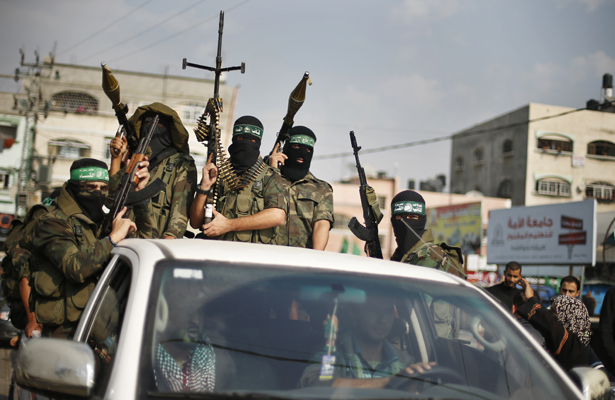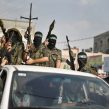
Gazan Jihadists Unite to Create New Operational Base in Sinai
Publication: Terrorism Monitor Volume: 11 Issue: 4
By:

After Hamas seized power in Gaza in 2007, jihadist groups began to emerge in the small Palestinian-controlled strip along the Mediterranean. The emergence of these groups was neither in the favor of Hamas nor the main regional actors, Israel and Egypt. Jihadist groups were responsible for various attacks against Israel and started to expand ties to sympathetic groups in Egypt’s security weak-point – the Sinai Peninsula.
Until recently, Gaza’s jihadists did not work under one umbrella. Various groups have been active in Gaza such as Jaljalt, Jaysh al-Islam, Jund Ansar Allah, al-Tawhid w’al-Jihad and Jaysh al-Ummah. These groups were formed by individuals who left Hamas and its affiliated Qassam Brigades after Hamas turned from armed resistance to political participation (al-Jazeera, April 21, 2011). Traditional Salafist groups that used to oppose political and military activism now act as recruitment bases for the emerging jihadi formations.
Hamas has cracked down on the jihadists several times, most famously in August, 2009, when Hamas forces attacked the Ibn Taymiyah mosque in Rafah, killing its imam, Abd al-Latif Moussa and 21 others (Ma’an, August 16, 2009). The attack followed a Friday sermon in which Moussa, the leader of jihadist group Jund Ansar Allah, had proclaimed an Islamic Emirate in Gaza. The incident is frequently cited in Salafist denunciations of Hamas.
The unification of Gaza’s many Salafist-Jihadist groups has been a major issue for the region’s jihadist ideologues. Before he was killed by an Israeli missile in October 2012, Hisham al-Saidini (a.k.a. Abu Walid al-Maqdisi) was among those ideologues that pushed for the jihadists’ unification. While still imprisoned by Hamas authorities, al-Saidini’s ambition was fulfilled in June, 2012 when jihadists announced the formation of the Majlis al-Shura al-Mujahideen fi Aknaf Bayt al-Maqdis (Mujahideen Shura Council in the Environs of Jerusalem) (al-Quds al-Arabi, October 14, 2012). According to a Gazan jihadist, al-Saidini was among the founders of the newly emerged group and many of the jihadist movements in Gaza are now under this new umbrella. [1]
Al-Saidini’s unification concept was inspired by his mentor, imprisoned Jordanian jihadist ideologue Abu Muhammad al-Maqdisi, who defended the idea of spreading the Salafi-Jihadist ideology “west of the [Jordan] river” (for al-Maqdisi, see Militant Leadership Monitor, July 30, 2010). Al-Maqdisi wrote an article in April 2009 urging jihadists in Gaza to unify under a clear jihadist banner similar to “Iraq and Afghanistan” and to “form a single group under one name, or at least to create one Shura council that expresses the ideas and aspirations of the Salafi-Jihadist movement in Palestine and the world.” [2]
The unification also has strategic purposes. According to an informed journalist in Gaza who spoke to Jamestown on condition of anonymity, the pressure imposed by Israel and Hamas has forced Gaza’s jihadists to move to the Sinai Peninsula in order to give themselves more room to operate against Israel: “Instead of operating on a 40 kilometer border with Israel they can operate on a 250 kilometer long border in Sinai. Additionally they have about 61,000 square kilometers to move freely.” [3]
The Sinai Peninsula, always a security weak-point for the Egyptian state, used to be controlled by the Mabahith Amn al-Dawla (MAD – State Security Investigations Service); however, after the January, 2011 revolution, this control loosened with the dissolution of MAD in March, 2011. Since then, the area has witnessed an increase in the number of violent incidents (both criminal and terrorist in nature), including the bombing of gas pipelines, firing of rockets into Israel and the kidnapping of tourists and foreign workers. Al-Qaeda leader Ayman al-Zawahri, has several times praised the targeting of Sinai pipelines carrying gas to Israel and Jordan. [4]
The jihadists in Sinai, including the biggest jihadist group in the area, Ansar Bayt al-Maqdis, appear to now be operating under the Mujahideen Shura Council in the Environs of Jerusalem umbrella and are influenced by Salafist-Jihadists in the Gaza Strip. This influence is strictly ideological as Gaza’s jihadists are unable to fund their colleagues in the Sinai.
The Gaza-Sinai nexus was explained by a Sinai jihadist in an interview with a Cairo news agency:
The interdependence [between jihadists from Gaza and Sinai] certainly exists organizationally and ideologically. Salafi-Jihadist groups in the Sinai and Gaza do not recognize borders; they are dealing with the Palestinian issue in terms of religious understanding. Even before the fall of the Mubarak regime, jihadists in the Sinai supported Gaza by weapons, supplies and military missions through the tunnels. [We have] also sheltered some of them who are wanted in Israel… On the other hand, Sinai jihadis have benefited from the expertise available in the [Gaza] Strip, some were sent there to receive training or to hide (Elkhabar.com [Cairo], September 21, 2012).
Apart from the mysterious incident in August 2012 in which no claim of responsibility was made after militants attacked Egyptian Army personnel and killed 16 soldiers, the jihadists’ ultimate goal and priority is to fight against Israel. However, as the Salafist-Jihadists do not consider Hamas or the Egyptian regime to be legitimate powers, Sinai can serve as a launching pad and safe haven for jihadists posing a threat to Hamas, Egypt and Israel alike.
Egyptian cooperation with Hamas could conceivably limit the influence of the jihadists due to Cairo’s peace agreement with Israel; however, the jihadists are still increasing their influence in Sinai for four reasons:
- Local young men are involved in the jihadist activities, making it difficult for local tribes to turn against their own sons;
- Tribal traditions of carrying arms can be exploited by the jihadists;
- Long-standing local grievances can be manipulated in the jihadists’ favor;
- The on-going political turmoil in Cairo limits the ability of the Islamist-led government to carry out counterterrorist operations in the Sinai Peninsula.
The conditions on the ground indicate that the influence of Gaza’s Salafi-Jihadists in the Sinai will continue to increase in the near future.
Notes
1. Interview with a Gaza-based jihadist, al-Quds (West Bank), October 15, 2012.
2. https://www.tawhed.ws/r?i=0504095p
3. Phone interview with a Gaza-based journalist, London, February 14, 2013.
4. Ayman al-Zawahiri, “A Message of Hope and Glad Tidings to Our People in Egypt (pt. 10),” As-Sahab Media, https://as-ansar.com/vb/showthread.php?t=64293.





